Instructions on how to install Ubuntu
If you are bored with Windows or Mac, or you are an IT hobbyist, switching to Ubuntu will help you satisfy that. Ubuntu is a computer operating system based on Debian GNU / Linux, a popular Linux distribution. The purpose of Ubuntu includes providing a stable operating system, updating it for ordinary users, and focusing on usability and ease of installation. In addition, Ubuntu is free and open source software, which means users are free to run, copy, distribute, research, change and improve the software. This is why IT people or software developers often use this operating system. In this article, TipsMake.com will guide you through the basic steps to install Ubuntu, please follow along.

1. Prepare before installing Ubuntu.
Similar to when installing windows, to install Ubuntu we need to have the Ubuntu installer ISO file and a 4Gb USB or higher.
- Link to download ISO Ubuntu: https://www.ubuntu.com/download
- Rufus software creates USB boot: https://rufus.akeo.ie
How to create Ubuntu bootable USB as follows:
You plug the USB into the computer, then open the software Rufus and do the following steps:
1 - Select the USB that you connect to the computer to create Boot.
2 - Select the Ubuntu ISO file that you have prepared.
3, 4 - You default to the picture.
5 - Name the USB.
6 - Choose the default FAT32, if the ISO file is larger than 4GB, select NTFS.
7 - Select the default as shown.
8 - Click Start to start creating USB boot.
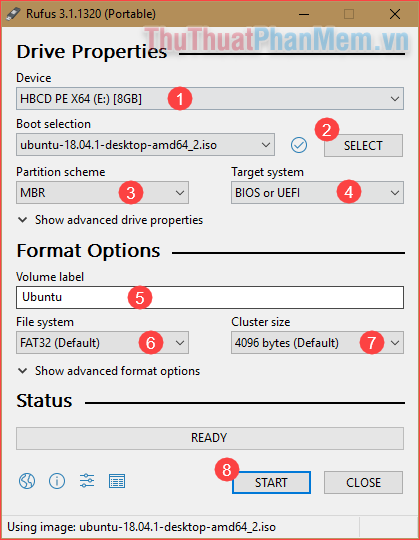
After clicking Start if a message appears, click Yes and OK.
2. Steps to install Ubuntu
Step 1 : You plug the USB boot created above into the computer and then restart. During the reboot process, choose BIOS and select boot from USB or CD.
List of BIOS access keys by mainboard:
- ASRock mainboard - Press the F2 key
- ASUS Mainboard - Press DEL, Print or F10 key .
- GIGABYTE Mainboard - Press the Del key to enter the BIOS Setup Utility.
- Intel Mainboard - Press F2 to enter BIOS Setup Utility.
- MSI (Micro-Star) Mainboard - Press the DEL key to enter the BIOS Setup Utility.
List of BIOS access keys by model:
Laptop SONY VAIO
- To get into the BIOS when restarting the computer you need to press the Vaio Assist key
Laptop HP - COMPAQ
- On some HP models, you will need to press F10 to enter the BIOS.
- To get into BOOT when restarting the computer you need to press and hold the F9 key
ACER Laptop
- To get into BOOT when restarting the computer you need to press and hold the F12 key
- To get into the BIOS when restarting the computer you need to press and hold the F2 key .
ASUS laptop
- To get into the BIOS when restarting the computer you need to press and hold the F2 key
- To get into BOOT when restarting the computer you need to press and hold the ESC key
LENOVO THINKPAD Laptop
- To get into the BIOS when restarting the computer you need to press and hold the F2 key
- To get into BOOT when restarting the computer you need to press and hold the F12 key
DELL Laptop
- To get into the BIOS when restarting the computer you need to press and hold the F2 key
- To get into BOOT when restarting the computer you need to press and hold the F12 key
Step 2 : After booting into USB, we will see the Ubuntu installation interface as shown below:
Here you have 2 options: Try Ubuntu (trial) and Install Ubuntu (install). We will choose Install Ubuntu to install.
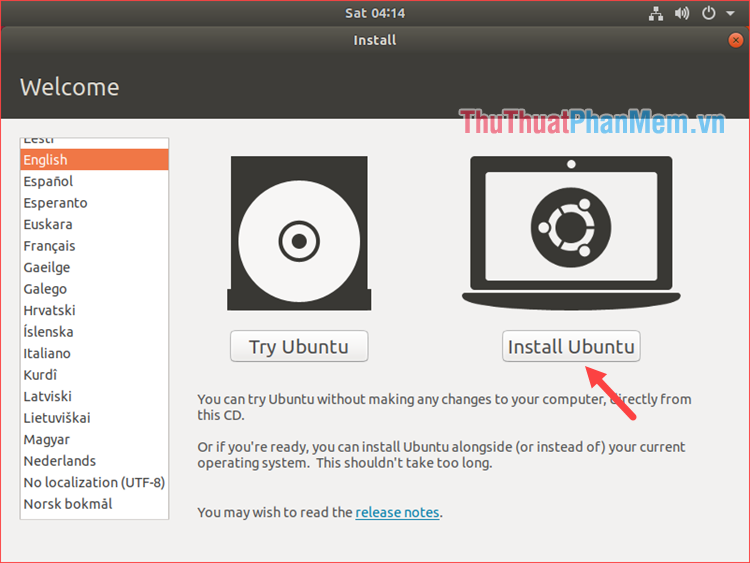
Step 3 : We choose the keyboard language for Ubuntu then click Continue .
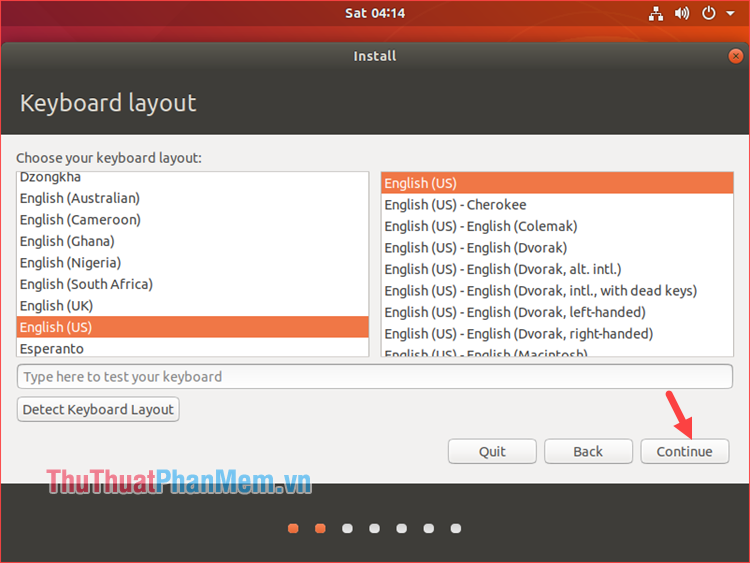
Step 4 : You can choose either of the following options:
- Normal installation : Normal installation with full software such as: web browser, utilities, office, games, and media player.
- Minimal installation : shortened installation includes only browser and utilities.
If you want to install quickly, select Minimal, if you want to fully, then select Normal.
Also, the two options under Other options are installing updates and third party software, so you can uncheck to save time during the Ubuntu installation process.

Step 5 : At the Installation Type interface, you will pay attention to 2 options:
- Erase disk and install Ubuntu: This option you need to pay attention, it will wipe all data in the hard drive when installing. Only select when your hard drive no longer has important data. If your computer has Ubuntu installed, you can select this option to install Ubuntu.
- Something else: If you want to install Ubuntu together with windows, you need to Check this option to create an Ubuntu installation partition.
Click continue to continue.
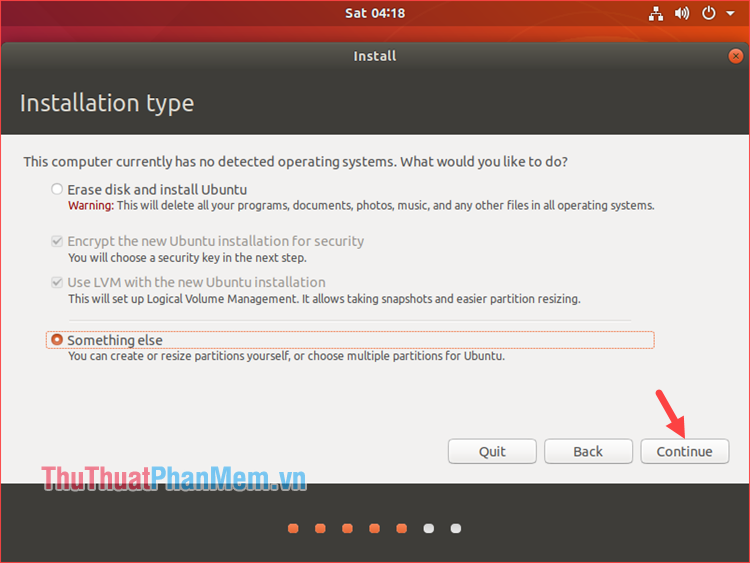
Step 6: After selecting Something else , the interface to create the Ubuntu installation partition appears. You can create the following partition type:
Swap Partition : This is the RAM partition for Ubuntu, you should choose the size of the Swap partition to double the amount of RAM in your computer.
/ Partition : This partition is the repository of Ubuntu data, we will install Ubuntu into this partition.
How to create a partition as follows:
To create a Swap partition, click on the Free Space partition and then click the plus sign.
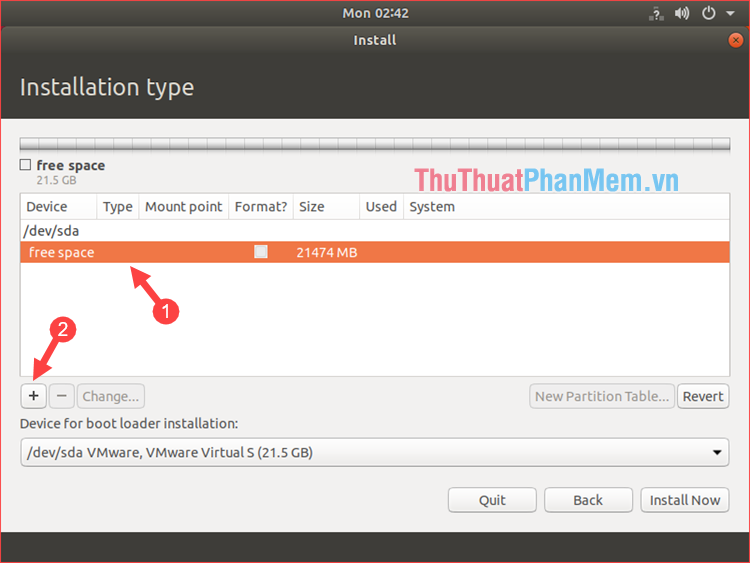
A small window appears, enter the amount of Ram in the Size box, then select the partition type is Logical , the Localtion for the new partition you choose Beginning of this space and the Use as select Swap area then click OK .
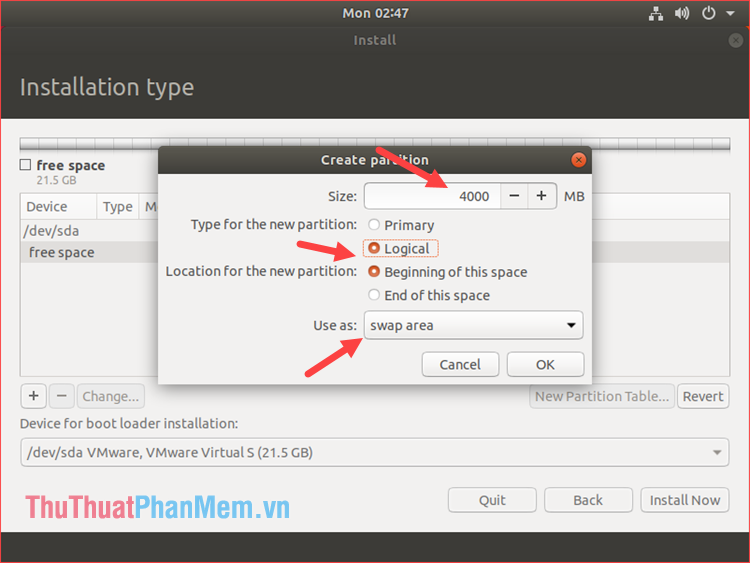
After creating the swap partition, we continue to click on free space and click the plus sign to create the partition /
You choose according to the picture below, Use as you default to Ext4 journaling file system , Mount point you choose /
Finally click OK.
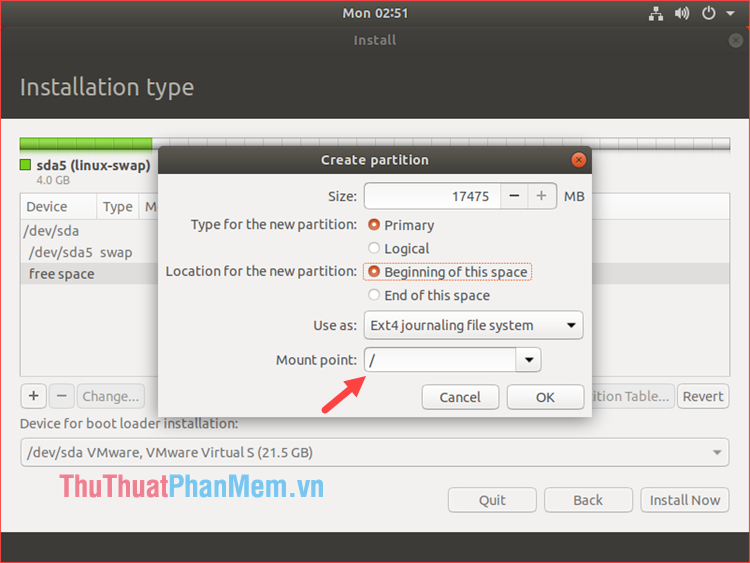
Step 7 : After creating 2 partitions, Swap and /, select the partition / and click Install now to install Ubuntu. If a message appears, click Continue.
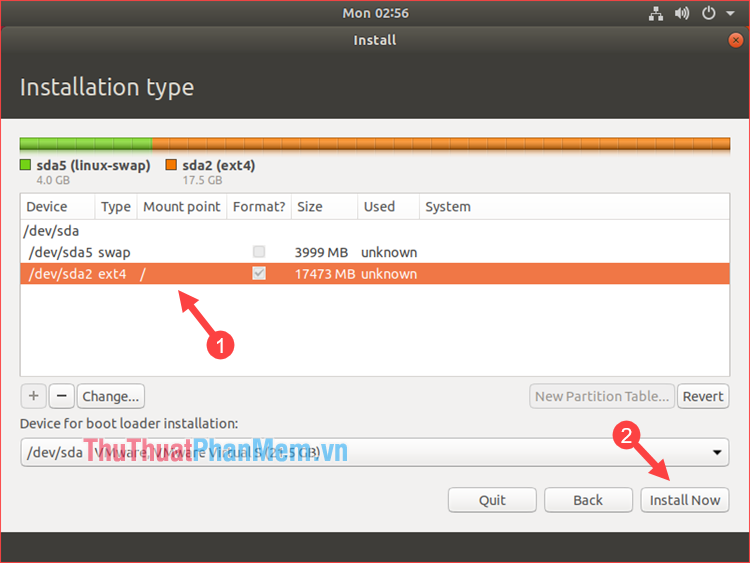
Step 8 : Select the Vietnamese time zone, then click Continue:
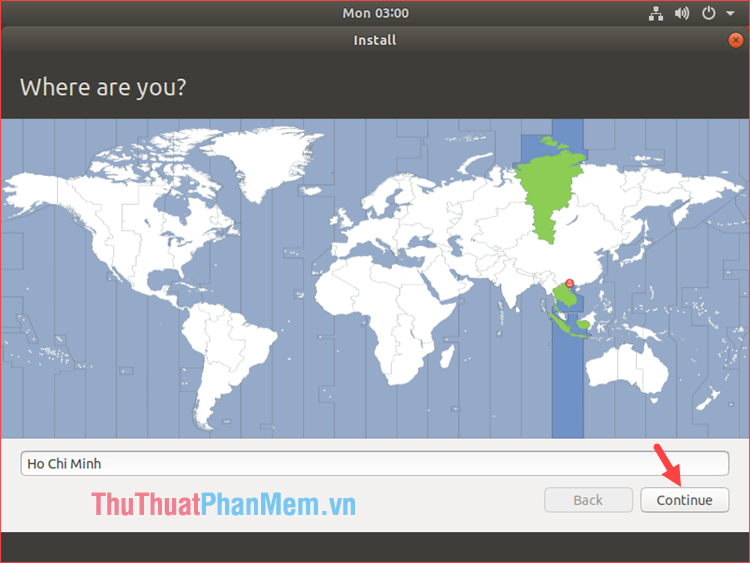
Step 9 : Enter your username and password and click Continue
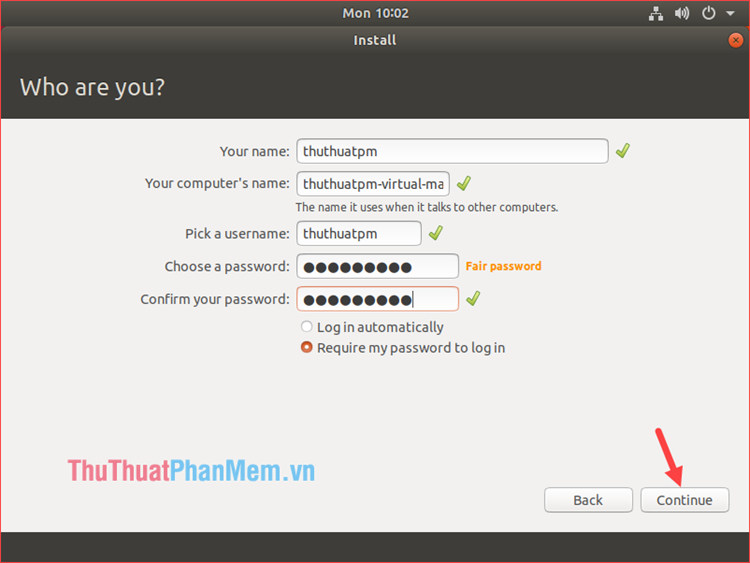
Now our job is to wait for the Ubuntu installation process to complete and reset the computer is done:
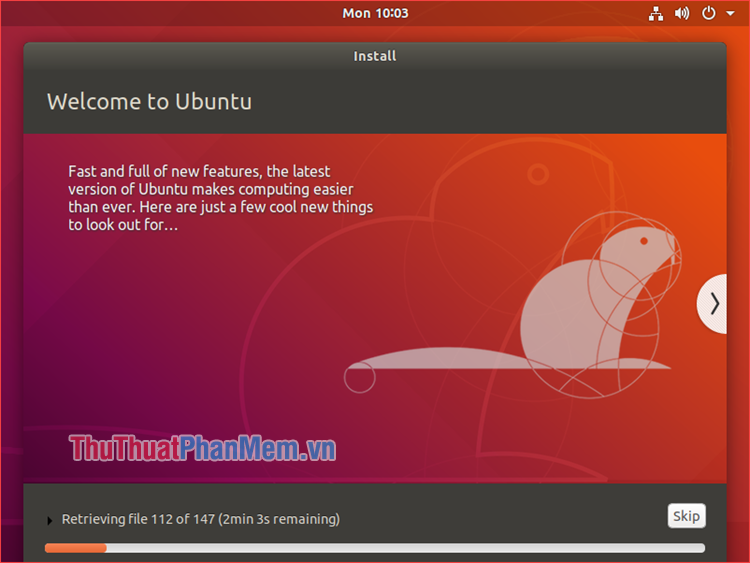
And here is the Desktop interface of the Ubuntu operating system:
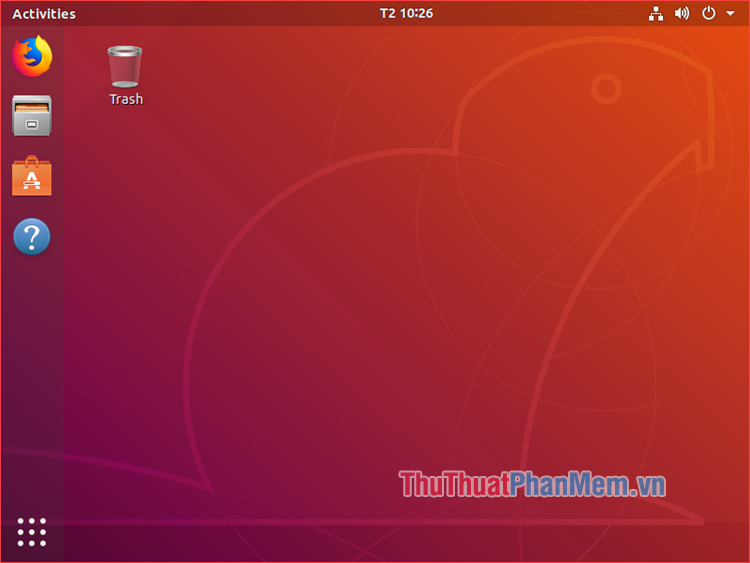
Above is a detailed guide on how to install Ubuntu, hopefully the article will help you to know how to install Ubuntu easily. Good luck!
You should read it
- Instructions to install Ubuntu directly from the hard drive
- Instructions for installing Ubuntu on VMware Workstation - Part 2
- Instructions for installing Ubuntu on VMware Workstation - Part 1
- How to install Putty SSH Client on Ubuntu 20.04 LTS
- Instructions for installing Google Chrome on Ubuntu operating system
- How to install Hyper Terminal in Ubuntu 20.04
- How to install Pip in Ubuntu
- How to Install CyberPanel on Ubuntu 20.04
May be interested
- How to Install CyberPanel on Ubuntu 20.04
 cyberpanel is a control panel designed to be user-friendly for non-technical users. cyberpanel is easy to learn as it uses a simple layout that most hosting companies are familiar with.
cyberpanel is a control panel designed to be user-friendly for non-technical users. cyberpanel is easy to learn as it uses a simple layout that most hosting companies are familiar with. - 5 things to do when installing Ubuntu on PC
 ubuntu is a powerful linux distribution suitable for a wide variety of use cases, ideal for both beginners and seasoned linux users.
ubuntu is a powerful linux distribution suitable for a wide variety of use cases, ideal for both beginners and seasoned linux users. - How to install µTorrent (uTorrent) in Ubuntu 20.04
 µtorrent provides clients for windows and macos x, however it is installed as a server in ubuntu linux and provides a web ui for managing downloads.
µtorrent provides clients for windows and macos x, however it is installed as a server in ubuntu linux and provides a web ui for managing downloads. - How to Install Ubuntu Linux Without CD (Windows)
 want to install ubuntu on your windows computer, but don't have a dvd or cd drive? there are a couple of different ways that you can install ubuntu on computers that don't have disc drives. the most common way is to create a bootable usb...
want to install ubuntu on your windows computer, but don't have a dvd or cd drive? there are a couple of different ways that you can install ubuntu on computers that don't have disc drives. the most common way is to create a bootable usb... - How to Install ClickHouse on Ubuntu 22.04
 clickhouse is a modern, fast and open source database management system used for online analytical processing (olap).
clickhouse is a modern, fast and open source database management system used for online analytical processing (olap). - How to install MySQL on Ubuntu 20.04
 in this article, tipsmake will show how to install mysql version 8.0 on ubuntu 20.04 server. by completing it, you'll have an active relational database that can be used to build your next website or app.
in this article, tipsmake will show how to install mysql version 8.0 on ubuntu 20.04 server. by completing it, you'll have an active relational database that can be used to build your next website or app. - How to install AVG Antivirus on Ubuntu
 in addition to windows, you can install avg antivirus on ubuntu easily and quickly to ensure that damage is minimized in the most optimal way. along with tipsmake, see how to install avg antivirus on ubuntu below.
in addition to windows, you can install avg antivirus on ubuntu easily and quickly to ensure that damage is minimized in the most optimal way. along with tipsmake, see how to install avg antivirus on ubuntu below. - How to install Ubuntu on a VMware virtual machine
 how to install ubuntu on a vmware virtual machine. ubuntu is a very popular operating system nowadays parallel to windows and macos. but ubuntu still makes many users wonder before upgrading should use on their own computers, so we still have a way to experience ubuntu.
how to install ubuntu on a vmware virtual machine. ubuntu is a very popular operating system nowadays parallel to windows and macos. but ubuntu still makes many users wonder before upgrading should use on their own computers, so we still have a way to experience ubuntu. - Ways to install Ubuntu on Windows, run in parallel or run separately
 there are many ways to install ubuntu on your computer, such as installing ubuntu from usb, cd, installing ubuntu running in parallel with windows, installing it
there are many ways to install ubuntu on your computer, such as installing ubuntu from usb, cd, installing ubuntu running in parallel with windows, installing it - Instructions for installing Ubuntu Maverick in Mac Virtualbox
 in the following article, tipsmake.com will show you how to install and use ubuntu inside mac os x through virtualbox ...
in the following article, tipsmake.com will show you how to install and use ubuntu inside mac os x through virtualbox ...










 How to install Ubuntu operating system in parallel with Windows 10
How to install Ubuntu operating system in parallel with Windows 10 What is Clipboard Explain the meaning of Clipboard in Windows
What is Clipboard Explain the meaning of Clipboard in Windows How to release RAM helps the computer run faster
How to release RAM helps the computer run faster What is PowerShell Basic commands in PowerShell
What is PowerShell Basic commands in PowerShell How to enter Safe Mode on Windows 7
How to enter Safe Mode on Windows 7 How to delete cached DNS on the computer using the Flush DNS command
How to delete cached DNS on the computer using the Flush DNS command